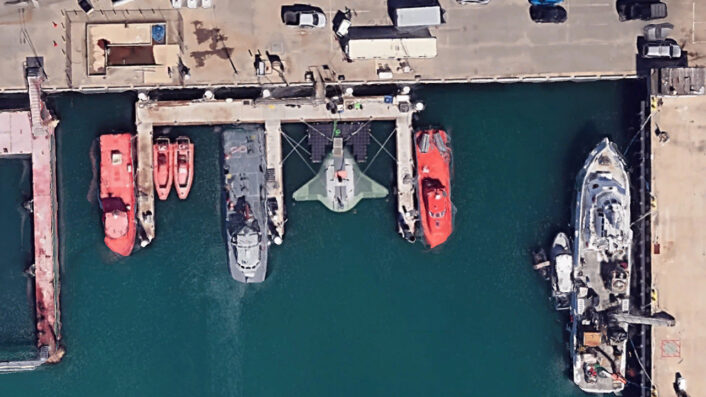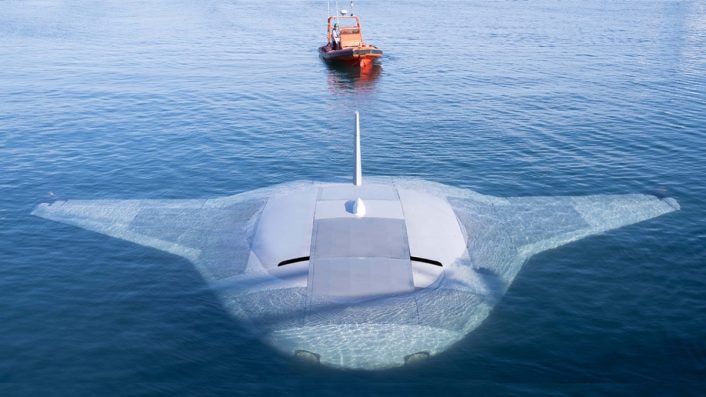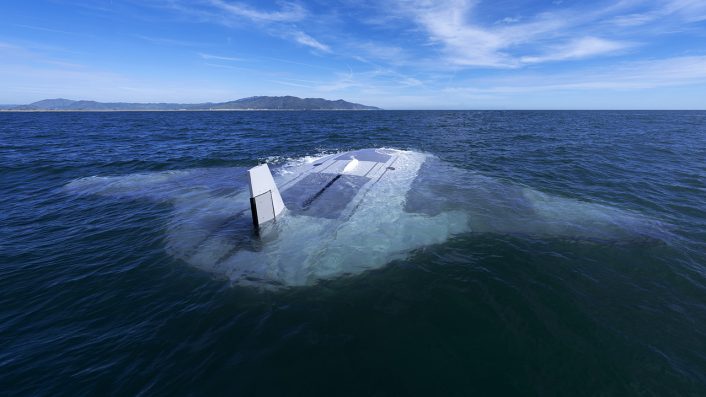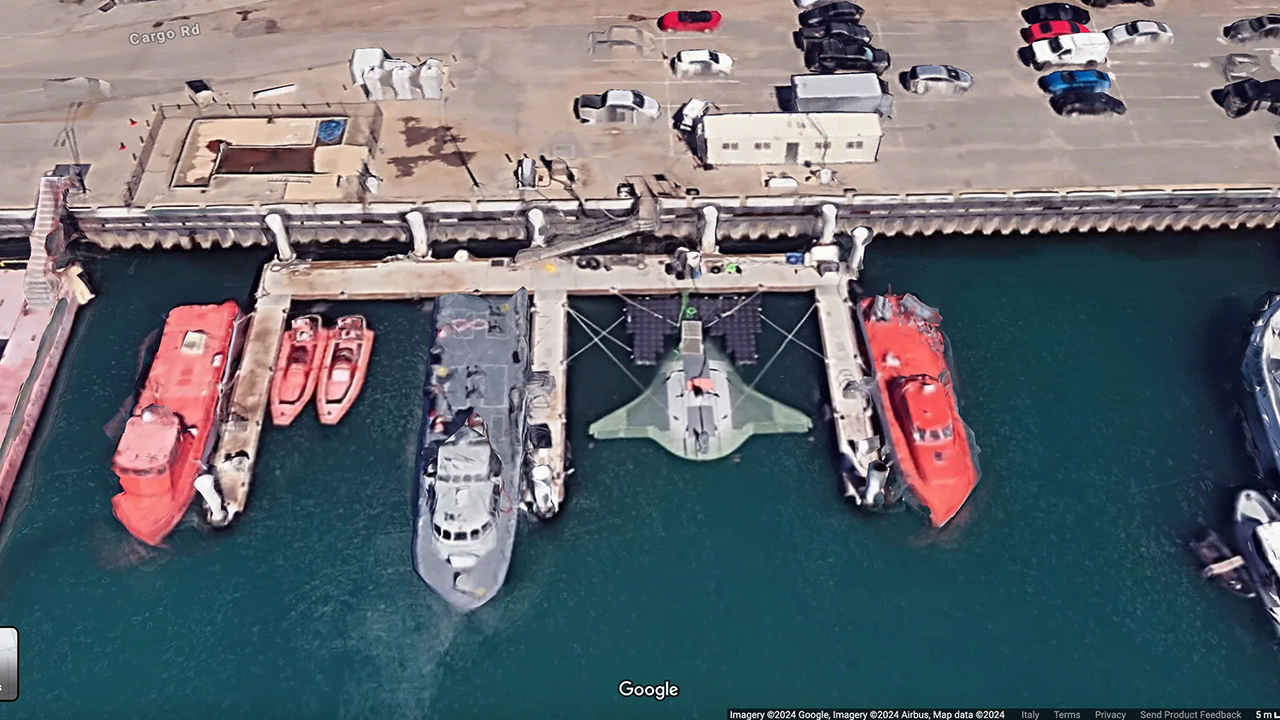Someone managed to find the prototype of Manta Ray docked at the Port Hueneme naval base in California in satellite images.
Manta Ray is an extra-large glider UUV, developed by Northrop Grumman for DARPA and designed to undertake extended-duration, long-range, and payload-capable undersea missions independently, without requiring on-site human logistics.
The Manta Ray prototype, that was unveiled in April 2024, underwent comprehensive full-scale testing off the coast of Southern California during February and March 2024: this testing phase focused on evaluating the vehicle’s hydrodynamic performance in real-world conditions.
The testing involved underwater activities using various propulsion and steering methods: buoyancy, propellers, and control surfaces. The newly released video highlights these activities, showcasing the prototype diving and resurfacing both while stationary and in motion.
Neither DARPA nor Northrop Grumman have disclosed additional details about the base from where the testing campaign of the new giant underwater drone has been launched. However, someone has spotted the Manta Ray docked at Naval Base Ventura County (NBVC) in Port Hueneme, California.
Someone managed to find the DARPA Manta Ray on google maps
Source:https://t.co/1VWGp9jzun#ufotwitter #ufox #uaptwitter #uapx pic.twitter.com/WE2R8Re9uG
— RAEFOS Network (@RAEFOSnet) June 20, 2024
This base is a significant operational center for the United States Navy and includes various facilities and units, such as the Construction Battalion (Seabees), and the Naval Air Warfare Center Weapons Division.
The prototype is clearly visible among other naval vessels, more or less in front of the Mission Package Support Facility (MPSF) in Building 1392 on the campus of Naval Surface Warfare Center.
The satellite images date back to November 2023 and they give a clear idea of the size of Northrop Grumman prototype of Manta Ray.

Naval Surface Warfare Center
The presence of the Manta Ray at Naval Surface Warfare Center makes a lot of sense, as the NSWC conducts a wide range of activities focused on the research, development, testing, and evaluation of surface warfare systems. These activities include engaging in basic and applied research to develop new technologies and improve existing ones; working on advanced materials, sensors, and weapons systems; testing of naval systems, including weapons, radar, sonar, and other electronic systems, to ensure they meet performance standards and are reliable in operational conditions. Moreover, the center builds and tests prototypes of new systems and components to evaluate their performance and feasibility and works to transition new technologies from the development phase to operational use, ensuring that the fleet has access to the latest advancements, collaborating with private industry, universities, and other research institutions to leverage additional expertise and resources.
In particular, according to the official website, Naval Surface Warfare Center, Port Hueneme Division (NSWC PHD) maintains technical expertise at locations across the United States: Engineering and Logistics at Port Hueneme, California; Search Radar Engineering at Virginia Beach, Virginia; and Live Fire Testing at White Sands, New Mexico. Port Hueneme Division is recognized as the Navy’s Center of Excellence for In-Service Engineering, Test and Evaluation, and Integrated Logistics Support for surface warfare combat and weapon systems.
“Since its inception in 1963, Port Hueneme Division, has been supporting the combat and weapon systems of the Fleet by providing highly skilled personnel and state-of-the-art facilities to lead the development and support of Navy surface ship warfare systems throughout their life cycles.”
“Port Hueneme Division is focusing its technical capabilities on Next Generation In-Service Engineering, which involves direct connectivity to the Fleet on a global basis and the immediate availability of round-the-clock access to products, services, and Fleet support capabilities. Next Generation In-Service Engineering will support predictive system failure, remote diagnostics, and corrective action via real-time, networked communications.”
Among the activities carried out by the Port Hueneme Division, there is also “overland live fire testing of Naval weapons in support of weapons systems acquisition (missiles and laser systems), assembly of weapons for overland and at sea live fire testing, launch of research rockets, and assembly/launch of low and medium fidelity theater ballistic targets.”
Manta Ray Program
The Manta Ray program, a DARPA initiative, aims to enhance technologies for future underwater unmanned vehicles (UUVs). It focuses on energy management, payload capacity, and low-power propulsion. Northrop Grumman highlights that Manta Ray will include advanced command, control, and communication (C3) capabilities, enabling long-duration operations with minimal human intervention. The data collected will improve decision-making for joint forces.

Development and Contracts
In 2021, Northrop Grumman received a Phase 2 contract to advance the Manta Ray program, which began in 2020. This phase involves developing full-scale demonstration vehicles by Northrop Grumman Systems Corporation and Martin Defense Group, each showcasing unique capabilities.

USO Theories
Speculations suggest that advanced underwater drones like Manta Ray could explain many Unidentified Submerged Object (USO) sightings. USOs are mysterious underwater phenomena similar to UFOs but occurring underwater.
The capabilities of Manta Ray, such as long-duration independent operation and advanced maneuverability, align with characteristics often attributed to USOs. The secrecy surrounding such drones fuels speculation that some USO sightings may actually be encounters with cutting-edge military technology.
As we commented in a previous post addressing these speculations, as more information about the Manta Ray and similar projects becomes available, it could demystify some of the USO sightings, providing a terrestrial explanation rooted in advancements in underwater drone technology. However, until there is direct evidence linking these drones to specific USO incidents, the connection remains speculative, contributing to the ongoing intrigue and debate surrounding unidentified underwater phenomena.













